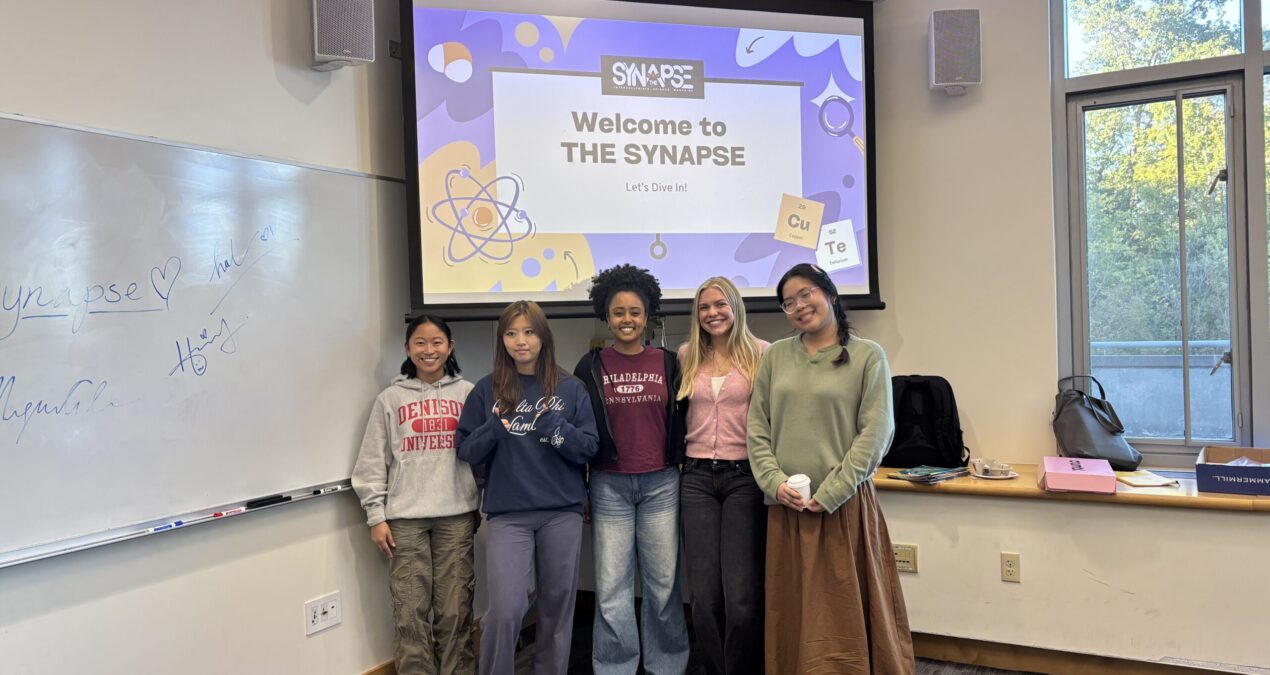Nhat Linh Dang, Staff Writer–
What do neurons, notebooks, and ideas have in common? “The Synapse,” where these three things meet, is back at Denison University, connecting students with science, arts, writing and collaboration.
While Denison’s branch of the Oberlin Intercollegiate Science Magazine “The Synapse” released an issue last semester, there were not many efforts to promote and advertise on campus. This semester, Denison’s branch of “The Synapse” has reemerged on campus. Their new executive team and new vision marks a renewed effort to connect science, arts, and writing across undergraduate communities.
The magazine relaunched with its first event on Oct. 9 and opened applications for new writers and editors for its upcoming Issue 43. For many Denison students, this revival reflects the growing interest in interdisciplinary approaches to science communication led by student publications.
“We are small but mighty,” said Managing Editor Haimanot Assefa ‘26, a global health and biology double major. “Our magazines are cool to look at. ‘The Synapse’ gives students interested in science the chance to explore a topic of their choice, whether through writing or drawing. It’s a really interesting space where artists and science-focused people can come together to create something.”
Founded as part of an intercollegiate collaboration led by Oberlin College, “The Synapse” operates across multiple undergraduate campuses. Its mission, defined from the name
“Synapse,” is to serve as a relay point for science-related information, just like nervous impulse passes from one neuron to another.
“Science writing is usually very formal and professional, using a lot of technical jargon and can feel intimidating. With “The Synapse”, though, you get to explore scientific topics in a more casual way,” Assefa added. “The articles cover different areas of science in a style that’s easier to read, less intimidating, and more fun to engage with. I think that’s how we help bridge that gap.”
Megan Carlson ‘26, outreach coordinator and biology and psychology double major, explained, “Not just like having a research paper and kind of just spewing out facts in a very technical language, “The Synapse” is sort of telling a story and then having some personal art that connects to it.”
“The Synapse” also functions as a collaborative platform that extends beyond Denison University by connecting students from multiple colleges through its intercollegiate network. The magazine’s vision is to create opportunities for students from different schools to meet and collaborate in person, rather than only working together only through the editing and submission process.
The intercollegiate model allows contributors and editors to gain experience working with peers virtually. Emma Kim ‘27, treasurer and event coordinator, biology major, highlighted the value of that cross-campus perspective.
“I think the cool thing about the editing role is that you get to work on pieces from people who aren’t necessarily from Denison,” Kim said.
Carslon added, “Kind of on the other end of that, being a writer helps you talk to some artists and some editors who you’ve maybe never met, which I think is pretty cool.”
Social Media Coordinator Catherine Kim’ 27, biology major, emphasized the goal of growing the magazine’s visibility this semester:
“Get a bigger audience, I guess, and get them together. We want to have creative fun events that will bring in a lot of students to get “The Synapse”’s name out. We really focus on that this semester.”
The team also emphasized that “The Synapse” is multidisciplinary in nature.
“People often say, ‘Oh, it’s just science,’ but it’s really much more than that,” Kim said. “It’s very multidisciplinary. You can write about biology, chemistry, or physics, but also any topics related to science. And even if you’re not interested in science, you can still contribute through art, editing, or writing. There’s a lot of experience you can gain in different areas.”
With Issue 43 underway, “The Synapse” has reestablished itself as a creative hub for Denison students. By combining science communication with art, writing, and student collaboration, the magazine offers a unique platform for students to explore ideas, connect with peers across disciplines and campuses, and develop skills in multiple fields.

